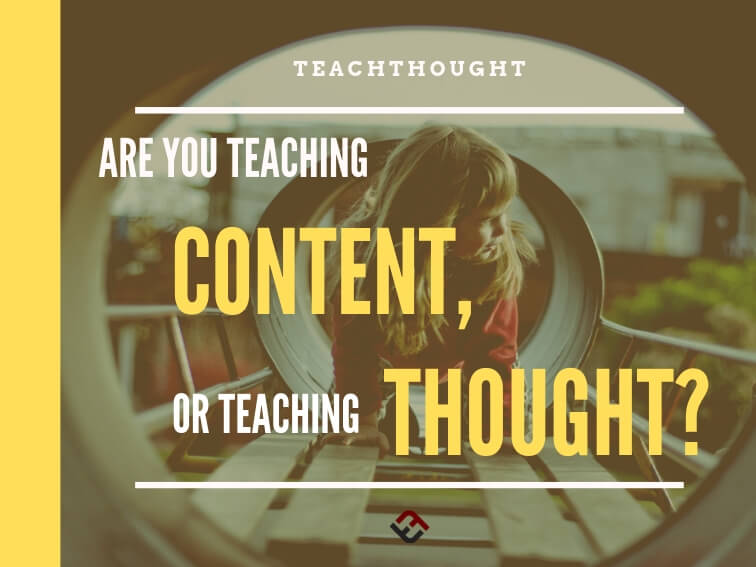
How Do You Know If You Are Teaching Content, Or Teaching Thought?
by Terry Heick
Thinking is troublesome.
For one, it is an intimate act splicing time and space. It is done right here, but it spans moments in the past and reaches out uncertainly towards moments in the future. Put another way, you think in a singular, precise space about plural, imprecise times.
It also resists uniformity (and education loves uniformity). Thought hinges on schema (familiar forms and patterns we then impose unfamiliar data to make sense of it), and emotion (in part, our internal response to the former). It is as diverse as character, experience, and affection. It’s like defining art, establishing criteria for beauty, or causing love
And whether it knows it or not, education has a thinking problem.
The Nature Of Thinking
Part of it is due to thinking’s oily skin.
What does it mean to understand, show curiosity, or think? We have tests to try to measure, but the assessment of thought isn’t the priority, but rather grasp of content–and this is another problem.
Priority.
One common response is to choose a handful of actions that indicate thinking–‘power verbs’–that we hang on the wall. We then form short response questions asking students to ‘Analyze,’ and ‘Evaluate,’ and feel bloody well that we’re rigorous.
But in this circumstance is thinking useful, or critical? Think about the fact that we promote ‘thinking strategies,’ which makes as much sense as a five-star restaurant promoting “cooking strategies.”
Shouldn’t a school fail to function without urgent and divergent thinking? Shouldn’t a classroom fall flat on its face when it’s not there? The way education is currently designed, the answer is no. We reteach, intervene, and remediate. Einstein’s definition of insanity seems apt here.
If our job is to teach skills, facts, and concepts–crystallized intelligence–then thinking is simply a tool, and our curriculum is content.
If our job is to teach critical thinking, design, and problem-solving–fluid intelligence–then thinking is our collective circumstance, and our curriculum becomes thought.
So, which is it?
If Curriculum Is Content
As an industry, our collective performance is far too mediocre to dabble here and there. When we make content proficiency our goal, all of our resources are applied there. Every unit we plan. Every walkthrough observation. Every PLC meeting we attend. Every PD we have the pleasure of experiencing. Every piece of technology we buy. Every grant we write.
We align everything in pursuit of that goal.
If our curriculum remains content, then we simply need to decide what our terms of success are, and continue to experiment until we turn all the little bar graphs that display all the data from all the assessments from red and yellow to green and blue. Or change our terms for success–new cut scores, softer assessments, etc.
Either way, critical thinking is necessarily secondary–a pathway rather than a destination or playground. And that’s okay as long as we’re on the same page here. As long as that’s what we want.
But if our curriculum is thinking–if our job is to, excuse the convenient phrasing, teach thought–then the classroom floor beneath us tilts right and then left, and our goals as educators change in important ways.
To learn to think, students need powerful and inspiring models that reflect the design, citizenship, creativity, interdependence, affection, and self-awareness we claim to want them to have.
To teach careful, creative, and truly innovative thinking, students need creative spaces and tools, and frameworks to develop their own criteria for quality and success.
They need dynamic literacy skills that they practice and build upon endlessly.
Not projects that have creativity and design thinking added on, but projects that can’t function without them.
And they need control of it all.
Units–if we use them–aren’t planned backward from standards, but thinking habits, self-direction, and intellectual urgency. If our curriculum is content, these are simply a means to a different end. Not priorities, but feel good phrasing we add to school mission statements and casually drop in parent conferences.
As teachers, we have an intimidating–borderline overwhelming–index of academic standards that every student needs to master. But as both an industry and a culture, we complain that students ‘can’t think for themselves.’
So which is it–should we teach content, or teach students how to think? This isn’t a false dichotomy; we can teach both thinking and traditional curriculum–teach one through the other–but it just might be that we’re trying to serve two masters and failing both.
Changing Curriculum Forms In Response To Changing Times
How would curriculum change if our priority was on critical, creative, and collaborative thinking?
What role would existing content play?
How would it change the kinds of interactions students have with ideas–and one another?
Would this be easier to assess, or more difficult? Would assessment continue to be central to how we drive learning, or would something else act as the catalyst–collaboration, creativity, ideas, models, etc.?
What does the reality of the modern age of information–this age of Google–suggest that we ‘teach’?
Do students need teachers less in such a context, or more than ever?
How should curriculum respond to a new world? Can we simply ‘update’ things as we go, or is it time for rethinking our collective practice?
What would you want for your own children–a curriculum of content, or a curriculum of thought?
And is it up to educators to decide? Where are parents and communities? Do they understand these shifts? Shouldn’t they? What’s at stake if they don’t?
Teachers are forced to squint at 21st century learning frameworks, Ken Robinson videos, Common Core standards, technology initiatives, and dozens of other ‘pushes’ and make sense of it all with students increasingly numb to their efforts.
So let’s be clear once and for all–in a public forum and accessible language that our local communities understand–where our priority lies.
Image attribution flickr user :::m@x:::; Are You Teaching Content, Or Teaching Thought?

